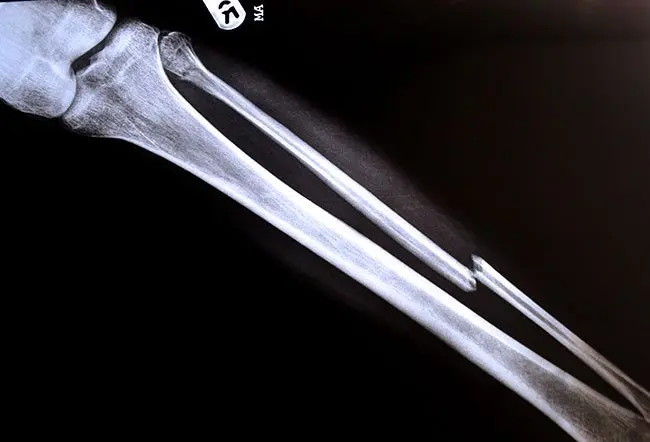- Fibula Healing Time
- Anatomy of the Fibula
- Functions of the Fibula
- Causes of Fibula Damage
-
Comments
-
**COMMENTSTAGLIST**
-
More
-
**OTHERTAGLIST**

The fibula is the long, thin bone of the lower leg on the side of the little toe. It runs parallel to the tibia or shin bone and plays a significant role in stabilizing the ankle and supporting the muscles of the lower leg. It is about the same size when compared with the tibia, but it is considerably thinner. The thickness corresponds to the varying roles of the two bones. The tibia bears the body weight from the knees to the legs whereas the fibula functions as a support for the tibia to stabilize weight. Many muscles of the thigh and lower leg attach to the fibula through the tendons. The fibula can also be harvested for tissue to graft onto other bones in the body. The fibula can get damaged due to various factors, such as a fracture. The fibula usually takes about three to six months to heal. Healing depends on many factors, such as age, vitamin D levels and the type of fracture. The healing may be faster by getting adequate rest, not putting too much weight on the leg and following the doctor’s care instructions.
Basic anatomy of the fibula
The fibula is located just behind the tibial head at the knee joint and then runs down until it reaches the ankle joint. The fibula and tibia are connected by a tissue sheet called the ridge on the medial surface of the fibula, which forms the interosseous membrane. The structure of the fibula can be broken down into the head, neck, shaft (body) and distal end of the fibula. As the head becomes narrow distally, the fibular neck is formed. The shape of the fibular shaft is determined by the muscle attachments. The distal (far) end of the fibula forms the ball of the ankle, which stays in contact with the bones in the foot.
Functions of the fibula
The fibula is one of the paired bones of the lower legs of humans. It connects with the tibia through appropriate articulation and ligaments. The fibula is the slender long bone in the body, considering its ratio of width to length. Some of the main functions of the fibula include
- It is not a weight-bearing bone. The main function is to combine with the tibia and provide stability to the lower limb and ankle joint.
- The distal end of the fibula has several grooves for ligaments attachments that stabilize and provide leverage during ankle movements.
- The lateral ligament attached to the fibular head provides knee stability.
- The fibula is often used as a donation site for bone grafts to repair bony structures in other parts of the body.
Causes of fibula damage
The most common significant medical conditions of the fibula are fractures. The possible causes of fractures are
- The main type of fracture occurs at the distal end of the bone and is classified as an ankle fracture. Trauma to the fibula can be caused by a single episode of significant twisting force or repetitive high-impact exercise forces.
- Repetitive high-impact exercises, such as running and jumping, can lead to stress fractures in the upper third part of the fibula.
- External twisting motions of the ankle can lead to spiral fractures of the distal (far) end of the fibula.
- Malignant tumors in the fibula are rare, but life-threatening. The proximal fibula is the common area to be affected by tumors which include osteosarcoma, giant cell tumors, chondrosarcoma and aneurysmal bone cysts.

QUESTION
Emotional trauma is best described as a psychological response to a deeply distressing or life-threatening experience. See AnswerTop How Long Does the Fibula Take to Heal Related Articles

Broken Bone
A broken bone is a fracture. There are different types of fractures and symptoms include pain, swelling, and discoloration of the skin around the injured area. Generally the recovery time for a broken bone is 4 to 6 weeks, depending on the circumstances of the injury.
Broken Bones
Broken bones are a common type of injury. Bones are some of the hardest tissues in the body, but they can break when they are stressed. Osteoporosis and cancer may cause bone fractures. The broken bone needs immediate medical treatment.
Can a Bone Fracture Heal on Its Own?
Learn what medical treatments can help your bone fracture heal and help you manage this condition.
Can You Walk on a Stress Fracture?
Stress fractures are tiny cracks that develop in the weight-bearing bones. These are often caused by repetitive force to bone such as during long marches, by repeatedly jumping up and down, or by running long distances. Because the cracks are tiny, you may be able to walk despite them, albeit painfully.
First Aid: Why You Need a First Aid Kit and CPR
First aid is providing medical assistance to someone a sick or injured person. The type of first aid depends on their condition. Preparedness is key to first aid, like having basic medical emergency kits in your home, car, boat, or RV. Many minor injuries may require first aid, including cuts, puncture wounds, sprains, strains, and nosebleeds. Examples of more critical first aid emergencies include heart attacks, strokes, seizures, and heatstroke.
Stress Fracture Picture
A fracture that occurs during the course of normal activity is called a minimal trauma fracture or stress fracture. See a picture of Stress Fracture and learn more about the health topic.
What Are the 4 Types of Fractures?
What are the four types of bone fractures? Learn the signs of bone fractures and how doctors treat them.
What Is the Fastest Way to Heal a Stress Fracture?
Learn what medical treatments can help ease your stress fracture symptoms and speed up your recovery.